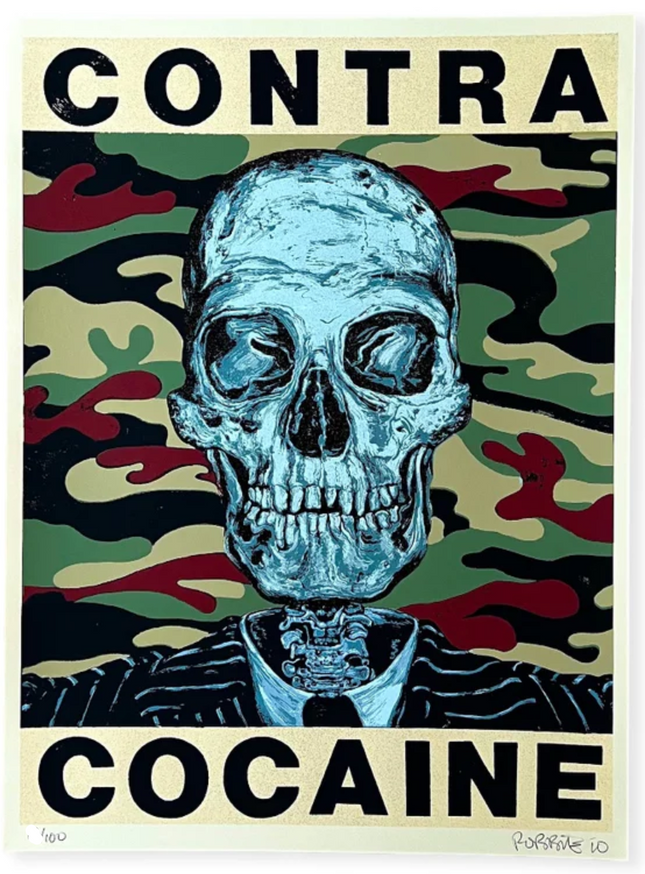
The Beautiful Losers

Robert "Robbie" Conal Contra Cocaine Glitter Silkscreen Print by Robert "Robbie" Conal
Contra Cocaine Silkscreen & Glitter Print by Robert "Robbie" Conal Hand-Pulled on Fine Art Paper Limited Edition Artwork. 2010 Signed & Numbered Limited Edition of 100 Artwork Size 18x24 Silkscreen Print Robert "Robbie" Conal's Contra Cocaine: A Landmark in Street Pop Art & Graffiti Artwork The artwork "Contra Cocaine" by Robert "Robbie" Conal is a watershed moment in the history of street pop art and graffiti artwork. The 18x24 silkscreen print, with its haunting skull imagery set against a camouflaged backdrop, is not just a visual statement but a political cudgel wielded with artistic precision. This hand-pulled print on fine art paper, a limited edition of 100, represents Conal's unapologetic foray into street art, a domain he has since come to dominate. Educated at Stanford and a master painter, Robbie Conal is known for his unflinching, intensely detailed portraits, often depicting political figures in grotesque forms. His highly political and active work provides a scathing commentary on political corruption and misconduct. "Contra Cocaine" is perhaps his most notorious piece, a symbolic representation of the Iran/Contra scandal that plagued the Reagan administration. Its original iteration in 1988 has the distinction of being a part of the permanent collection at the Los Angeles County Museum of Art (LACMA), underscoring its cultural and historical significance. Contra Cocaine: The Intersection of Art and Political Activism Conal's "Contra Cocaine" transcends mere artistic endeavor; it encapsulates the artist's commitment to confronting and exposing the dark underbelly of political power structures. The piece is a grim commentary on the Iran/Contra affair, with the skull serving as a macabre symbol of the deadly consequences of political gamesmanship. Using street art's stark, compelling visual language, Conal's work becomes accessible and engaging, drawing the public into a conversation about the often invisible mechanisms of government wrongdoing. The distribution of "Contra Cocaine" through street posters in cities across the United States marked Conal's initial exploration into street art. This guerrilla postering, a form of grassroots activism, was designed to provoke public discourse and bring political commentary out of the galleries and into the streets. The image became synonymous with a generation's disillusionment and rage, channeling the spirit of protest into a singularly impactful piece of art. Legacy and Influence of Robbie Conal in Street Art Robbie Conal's influence on street pop art and graffiti artwork is profound. His commitment to marrying art with activism has inspired countless artists to view the urban landscape as a platform for social commentary and change. Plastering "Contra Cocaine" posters around the country was not just an artistic statement but a call to arms, engaging a volunteer "army" of supporters to disseminate the powerful image far and wide. Conal's method of engagement—activating a network of volunteers to distribute his posters—echoes the collective nature of street art, wherein the community plays a crucial role in the dissemination and reception of the work. The "army" that Conal mobilizes speaks to the collaborative spirit of the street art movement, blurring the lines between artist and audience, between individual creation and collective experience. Contra Cocaine: A Statement of Artistic and Historical Importance The historical context of "Contra Cocaine" amplifies its importance in the annals of street art. Published on the occasion of the exhibition "The Missing Link" at Country Club in 2010, the print also belongs to the Beautiful Losers Archive and Iconoclast Editions, collections that honor the works of artists who have shaped the landscape of contemporary art outside traditional systems. "Contra Cocaine" not only cements Robbie Conal's place in street art history but also stands as a testament to the power of visual art as a means of political resistance and societal reflection. As a piece of street pop art and graffiti artwork, it represents the genre's potential to influence public opinion and spark dialogues that transcend the visual medium, entering the realm of collective memory and historical documentation. The continued relevance of "Contra Cocaine" lies in its unabashed confrontation with political corruption and how art can expose and critique those in power. Through this work and his broader artistic oeuvre, Robbie Conal demonstrates the enduring role of the artist as a provocateur and a social commentator, wielding brushes and silkscreens as others might wield pens or protest signs. His legacy in street art is defined by his distinctive visual style and his unwavering commitment to activism through art.
$750.00


